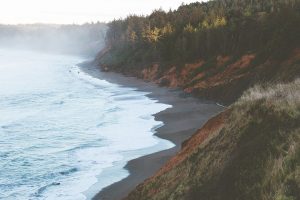Our identity and heritage have been based on our natural resources. We overlook the mighty Pacific. Rivers, wetlands, creeks, beaches and green bluffs all make up the wild and windy landscape. Our residents appreciate the community’s environment with fresh air, changing cloud formations all the way to the horizon, gorgeous sunsets, a mild climate and dark night sky.
Like many small American towns, Port Orford is in a time of transition between our history and our future, trying to find the best way to shape development to protect and enhance our unique nature.
Our past is rooted in fishing and timber, particularly the beautiful but endangered Port Orford cedar. The timber has faded, but the fishing remains a vital part of our community.
The natural harbor at the north end of Port Orford Bay has one of only two “dolly docks” in the US and six in the world, where boats are lifted in and out of the water by huge cranes and parked on large, custom-made trailers on the dock. A working fishing port, the Port Of Port Orford is home to almost 30 commercial fishing boats, which landed nearly $5 million in product last year.
We are also known for our active artist community, with several galleries owned and operated by working artists, and for some of our beautifully maintained historic sites, such as Hughes House and the Coast Guard Lifeboat Station.
We’re located on Oregon’s beautiful South Coast, often called the Wild Rivers Coast—halfway between Gold Beach and Bandon, about an hour north of the Oregon/California border; just south of Cape Blanco, a headland terrace dated at 80,000 years old, and north of Humbug Mountain, the tallest mountain in Oregon to rise directly from the ocean.
The nearest major city is Coos Bay, 44 miles north, and we are 266 miles from Portland, about a 5-hour drive. Click here for flight information…
History
Before the arrival of Euro-American settlers, the site of Port Orford was inhabited by the Native American Qua-to-mah tribe of the Tututni peoples. Captain William Tichenor brought the first European settlers by boat in 1851, and after a violent battle and subsequent displacement of native peoples, the settlers established the town of Port Orford in 1856.
Port Orford’s name owes to its proximity to Cape Blanco, which Captain George Vancouver—when sailing past in 1792—called Cape Orford in honor of his friend, the Earl of Orford. Port Orford was officially incorporated as a city in 1935.
Click for more information about our fascinating history...
Port Orford Information
Area
Port Orford encompasses 1.6 square miles, including Garrison Lake, a 130-acre freshwater lake and associated wetlands.
Population
As of the 2020 census, Port Orford had 1,146 people, in 581 households. The median age of residents is 62.7.
The median household income is $24,348
While our population numbers have remained fairly stable over the past 50 years, changing demographics reflect a shift that is becoming more pronounced over time: a change from a natural resource-based economy to a retirement and service economy.
Socioeconomic Trends
The harbor’s commercial fishing fleet and processing facilities, together with service industries and summer tourism, are the economic mainstays of the community.
Today, commercial fishing continues to be a significant economic sector of the community. The Port estimates that between 90 and 120 people are directly or indirectly involved with the commercial fishing industry in Port Orford. A number of businesses provide services such as fabrication, tools and supplies, which support the industry. The Port facility is an important feature because of its economic impact on the community, and because of the unique ambiance that attracts the local population and visitors.
Tourism continues to be a significant employer for the community. Port Orford’s location on the Pacific Ocean provides ambiance, and its location along Highway 101 provides exposure to the traveling public. The natural beauty of the area, its unspoiled environment, and the authentic feel of the community are magnets that appeal to visitors.
Weather
Average rainfall: 74″
Hottest month: July
Coldest month: Jan
Wettest month: Dec
Driest month: July



